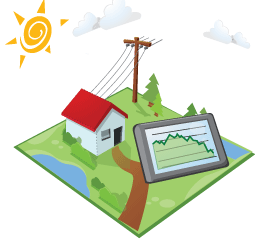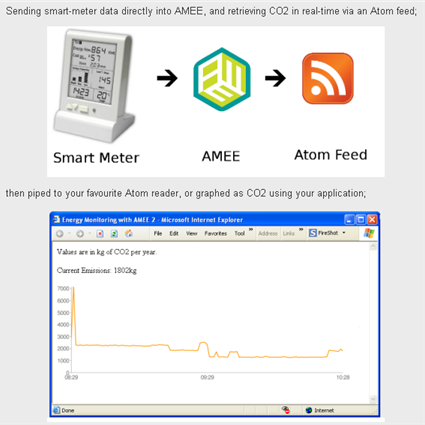 There’s no question we’re in a bad mess when it comes to state of our power grid, not only in the United States but globally.
There’s no question we’re in a bad mess when it comes to state of our power grid, not only in the United States but globally.
Revamping how we track and use power is crucial for our generation. Which is why I’m delighted to be moderating a panel where we’ll reveal some of the latest innovations in this area. It’s happening at the DEMO conference in Palm Springs, Calif. next week. (This will be one of three VentureBeat-hosted sessions highlighting the most important tech trends of our day. The other two will cover social data sharing and productivity 2.0)
The panel will detail how our power grids need to be changed and will discuss why what’s being called the “open power grid” is so important. Best of all, our panelists will give you a glimpse of some eye-opening technologies that will not only push us closer to a more open grid but allow us to start exploiting it right now.
For too long, the energy sector has been owned by large utilities who’ve felt no need to be transparent about how much energy we’re using. If you were to walk into a supermarket for a loaf of bread and the store didn’t have any information about its price or ingredients, you’d probably hightail it out of there. But that’s basically what’s happening with our energy usage. We’re consuming too much but are blissfully ignorant about what it’s doing to our environment: The threat of global warming is worsening, according to most scientists. Our power grid is a closed, proprietary system for the most part, and we desperately need an open view of it if we’re going to effect change.
AI Weekly
The must-read newsletter for AI and Big Data industry written by Khari Johnson, Kyle Wiggers, and Seth Colaner.
Included with VentureBeat Insider and VentureBeat VIP memberships.
The stakes are huge. The power market in the US alone is worth at least around $1 trillion, and we’ll be seeing $100 billion (yes, billion) in capital investments every year over the next decade. This is a very large pie — subject to all sorts of disruption from entrepreneurs and coming federal policy. And on Tuesday we’ll be hearing from several innovators.
 First up, we’ll have Tom Sly, product lead of Google PowerMeter, an ambitious Google project — still in its infancy — that intends to tell you exactly how much energy you’re using for any appliance in your home. This will be the first time Sly has spoken about the project, and he’ll be explaining what Google needs from federal regulators to pull this off.
First up, we’ll have Tom Sly, product lead of Google PowerMeter, an ambitious Google project — still in its infancy — that intends to tell you exactly how much energy you’re using for any appliance in your home. This will be the first time Sly has spoken about the project, and he’ll be explaining what Google needs from federal regulators to pull this off.
We’ll also have Adrian Tuck, chief executive of a startup called Tendril, reveal a new product that improves how consumers communicate with their utility. Out of fairness to other media, I won’t disclose the details here, but suffice it to say, the product will give consumers a new way to choose how and when they use their power. Already, Tendril has been a trailblazer in Texas, working with utilities such as Reliant Energy to give consumers Web access (and additionally, an in-home display) to see how much power they’re using and where the power comes from (dirty coal, cleaner natural gas, wind or solar, and what’s the mix). Tendril, too, is lobbying for an open grid. The more transparency and competition, the more utilities will respond to consumer pressure and serve consumers information.
 Finally, we’ll have Robin Baker, of AMEE, a company that for the first time is collecting data about energy usage from any source it can get it from — and keeping everyone honest. It’s doing so in an open source, crowd-sourcing way (it runs a Wiki where people are allowed to enter data and see where it is coming from). Run by ex-Nasa scientists, and backed by Silicon Valley angel Tim O’Reilly among others, AMEE will show how you can track your carbon footprint in real time (and even through an RSS feed; see diagram).
Finally, we’ll have Robin Baker, of AMEE, a company that for the first time is collecting data about energy usage from any source it can get it from — and keeping everyone honest. It’s doing so in an open source, crowd-sourcing way (it runs a Wiki where people are allowed to enter data and see where it is coming from). Run by ex-Nasa scientists, and backed by Silicon Valley angel Tim O’Reilly among others, AMEE will show how you can track your carbon footprint in real time (and even through an RSS feed; see diagram).
Until now, lots of “carbon neutral” companies have made promises to help you reduce your footprint. But there’s no single authority or regulatory agency that dictates how carbon usage should be calculated. If you buy a can of Coke from a store, no one really knows where it came from. Did the truck delivering it come from Seattle, or Chicago? How much energy did that truck consume? AMEE aims to track this entire supply chain to calculate more accurate carbon footprints. In some cases, such energy flow data is sensitive, because it may reveal secrets about how a company’s business process works. AMEE agrees to anonymize the data, collecting it from different parties in exchange for promises it won’t reveal the source.
Such intense tracking is necessary to ensure compliance with new sorts of regulations such as national and international carbon cap-and-trade laws. The US and other countries are increasingly moving toward such legislation. Separately, AMEE also offers its data to third-parties, so they can build applications on top of it. Every large company will want to understand what AMEE is doing. Based in London, it has the UK government as its client. It’s now seeking to get other clients, such as the US Environmental Protection Agency.
 After you’ve seen the presentations from these three companies, you’ll understand why all three may soon be coming together in an alliance to offer consumers some sweeping new controls over their power usage. In some regions, where market and regulatory conditions are favorable — such as Texas — they may be moving more quickly than in others.
After you’ve seen the presentations from these three companies, you’ll understand why all three may soon be coming together in an alliance to offer consumers some sweeping new controls over their power usage. In some regions, where market and regulatory conditions are favorable — such as Texas — they may be moving more quickly than in others.
Google is lobbying hard to make sure the grid is built in an open way. President Obama has drafted a 2010 budget that will provide the DoE $26.3 billion to fund clean energy initiatives, including funds for a “smart power grid” project. The proposed DoE budget also includes funds for loan guarantees for energy efficiency programs. Google and other says it’s important to avoid forcing the grid to run on a single protocol (GE, for example, an incumbent vendor of components for the energy grid, is hoping to make Internet Protocol the grid’s main communication standard). See what GE and Google have been saying lately here.
I’m exited to be hosting this panel and hope you’ll join us.
VentureBeat's mission is to be a digital town square for technical decision-makers to gain knowledge about transformative enterprise technology and transact. Learn More